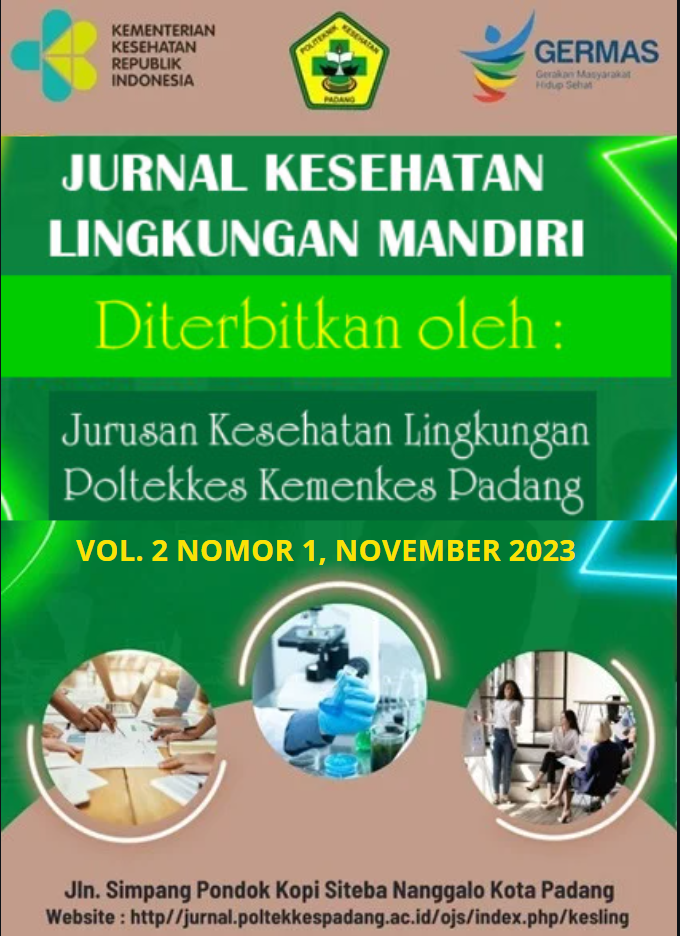Modifikasi Biopori sebagai Optimalisasi Laju Infiltrasi Air Hujan dan Dampak bagi Pengomposan Bahan Organik
Abstract
Accelerated development. housing on hard land, expanding house plots, filling in new land from wetlands, and changing residences into shops or offices. This causes a decrease in the capacity and carrying capacity of the environment on the earth's surface. The aim of this research is to determine the type of organic material in the biopore media which has a significant influence on the rate of water infiltration into the soil. The type of research is Quasi-experimental, with a post test only design using the Experimental Perspective Cohort method. Observations were carried out repeatedly according to the time required during the organic material degradation process in the biopores then analyzed using the true triangle experiment, namely by analyzing the components in the modified biopore media. The data that has been collected in this research is then analyzed using quantitative descriptive analysis by describing the data through the Oneway Anova Variance Test with a degree of confidence of 0.05. The research results show that the modified biopori instrument with organic vegetable material in it can maintain the rate of water infiltration into the soil. The fastest average rate of water infiltration into the soil was found in the modified biopore instrument with vegetable organic material, namely 191.16 mm/minute. The results of analysis on organic materials show teak leaves with a value of sig.0.011, vegetables with a value of sig. 0.022, straw obtained a sig value. 0.002, and paper with a sig value. 0.111. The type of vegetable organic material in the modified biopore instrument is more effective and faster in returning the rate of water infiltration into the soil to normal.
Downloads
References
Santoso S, Soekendarsi E, Hassan MS, , F, Litaay M, Priosambodo D. Biopori Dan Biogranul Kompos Sebagai Upaya Peningkatan Peduli Lingkungan Di Sman 4 Kabupaten Soppeng. J Pengabdi Masy Univ Merdeka Malang. 2019;3(0):1–5.
Putri MSA, Syakbanah NL, Affandy NA, Nabilah S, Arismaya ARPA. Socialize the Biopore Modification and Utilization as a Composting Media and Disaster Mitigation Efforts in Blawi Village, Karangbinangun, Lamongan. ABDIMAS J Pengabdi Masy. 2022;5(2):2472–8.
Kumar V, Chaplot B, Omar PJ, Mishra S, Azamathulla HM. Experimental study on infiltration pattern: opportunities for sustainable management in the Northern region of India. Water Sci Technol. 2021;84(10–11):2675–85.
Hutapea S, Aziz R. Waste Management with the Technology of Biopore Hole Absorption (LRB) Based on Biochar in Medan, Indonesia. IOSR J Environ Sci [Internet]. 2018;12(2):77–82. Available from: www.iosrjournals.org
Putri RD, Haes PE, Sanjaya IGEKA, Ayu IDA, Sukmarini G, W IDGA, et al. TEKNOLOGI BIOPORI DALAM PENGELOLAAN SAMPAI ORGANIK DI DESA CAU BELAYU , TABANAN BALI Universitas Pendidikan Nasional PENDAHULUAN Desa Cau Belayu berlokasi di kecamatan Marga , Kabupaten Tabanan merupakan daerah dengan ketinggian 500- 700m diatas permukaan. 2022;3(2):280–6.
Nileshwari Y, Pandagale VP, Madhuri G, Khambalkar VP. Research Article MEASUREMENT OF INFILTRATION ON DIFFERENT LAND COVERS. 2016;8(51):2299–302.
Mahapatra S, Jha MK, Biswal S, Senapati D. Assessing Variability of Infiltration Characteristics and Reliability of Infiltration Models in a Tropical Sub-humid Region of India. Sci Rep. 2020;10(1):1–18.
Salim N. Study of Use of Biopory Hole for Flood Management in Housing Area ( Case Study of Permata Indah Housing , Jember Regency ). 2021;6(12):37–44.
Alberto I. J. Vich, 2013, Adjustment of Infiltration Models in Poorly Developed Soils, Open Journal of Modern Hydrology, Vol. 3 8-14. No Title.
Murti Juliandari, dkk, 2013,Efektivitas Lubang Resapan Biopori terhadap Laju Resapan (Infiltrasi), Jurnal Teknologi Lingkungan Lahan Basah.
Habibiyah, 2016, Pengaruh Jenis Sampah, Variasi Umur Sampah Terhadap Laju Infiltrasi Lubang Resapan Biopori (LRB), Jurnal Wahana Tri Dharma Perguruan Tinggi, Universitas PGRI Adi Buana Surabaya Volume 66, Nomor 1.
Yusuf Maulana, Annand (2017) Studi Laju Infiltrasi Air Lindi Pada Timbunan Sampah Organik Yang Berbasis Sanitary Landfill. thesis, e-print, Universitas Brawijaya.
Atanu Mukherjee, et al, 2020, Impacts of Organic and Conventional Management on the Nutritional Level of Vegetables, Sustainability,MDPI Journals, Volume 12,Issue 21.
E. C. Brevik, and T. J. Sauer, 2014,The past, present, and future of soils and human health studies,SOIL Discuss,1, 51-80.
Copyright Notice
Pernyataan Hak Cipta dan Lisensi
Dengan mengirimkan manuskrip ke Jurnal Kesehatan Lingkungan Mandiri, penulis setuju dengan kebijakan ini. Tidak diperlukan persetujuan dokumen khusus.
Hak Cipta :
Lisensi Creative Commons Atribusi-NonKomersial-BerbagiSerupa 4.0 Internasional
Hak cipta atas artikel apa pun di Jurnal Kesehatan Lingkungan Mandiri dipegang penuh oleh penulisnya di bawah lisensi Creative Commons CC BY-NC-SA 4.0.
- Hak cipta pada setiap artikel adalah milik penulis.
- Penulis mempertahankan semua hak mereka atas karya yang diterbitkan, tak terbatas pada hak-hak yang diatur dalam laman ini.
- Penulis mengakui bahwa Jurnal Kesehatan Lingkungan Mandiri sebagai yang pertama kali mempublikasikan dengan lisensi Creative Commons Atribusi 4.0 Internasional (CC BY-NC-SA-4.0).
- Penulis dapat memasukan tulisan secara terpisah, mengatur distribusi non-ekskulif dari naskah yang telah terbit di jurnal ini kedalam versi yang lain (misal: dikirim ke respository institusi penulis, publikasi kedalam buku, dll), dengan mengakui bahwa naskah telah terbit pertama kali pada Jurnal Kesehatan Lingkungan Mandiri.
- Penulis menjamin bahwa artikel asli, ditulis oleh penulis yang disebutkan, belum pernah dipublikasikan sebelumnya, tidak mengandung pernyataan yang melanggar hukum, tidak melanggar hak orang lain, tunduk pada hak cipta yang secara eksklusif dipegang oleh penulis.
- Jika artikel dipersiapkan bersama oleh lebih dari satu penulis, setiap penulis yang mengirimkan naskah menjamin bahwa dia telah diberi wewenang oleh semua penulis bersama untuk menyetujui hak cipta dan pemberitahuan lisensi (perjanjian) atas nama mereka, dan setuju untuk memberi tahu rekan penulis persyaratan kebijakan ini. Jurnal Kesehatan Lingkungan Mandiri tidak akan dimintai pertanggungjawaban atas apa pun yang mungkin timbul karena perselisihan internal penulis.
Lisensi :
Jurnal Kesehatan Lingkungan Mandiri diterbitkan berdasarkan ketentuan Lisensi Creative Commons Atribusi-NonKomersial-BerbagiSerupa 4.0 Internasional (CC BY-NC-SA 4.0). Lisensi ini mengizinkan setiap orang untuk :
Menyalin dan menyebarluaskan kembali materi ini dalam bentuk atau format apapun serta menggubah, memperbaiki, dan membuat ciptaan turunan, bahkan untuk kepentingan komersial, selama mereka mencantumkan kredit kepada Penulis atas ciptaan asli.

















